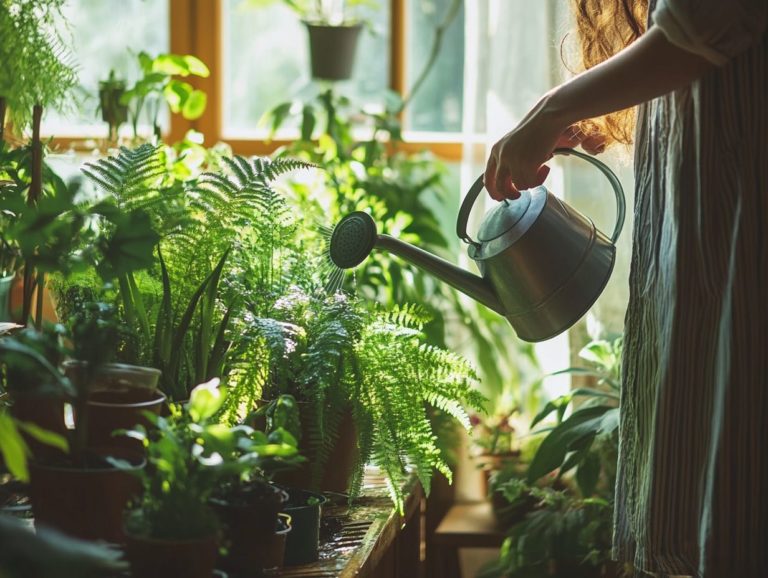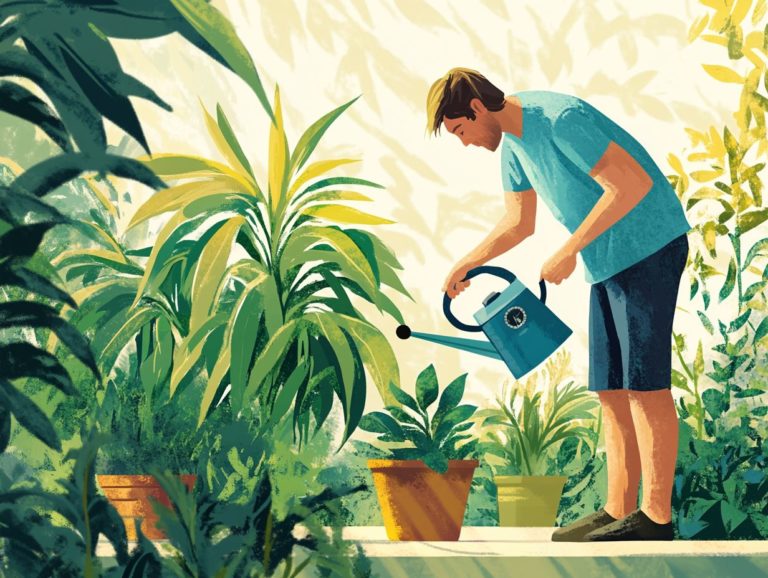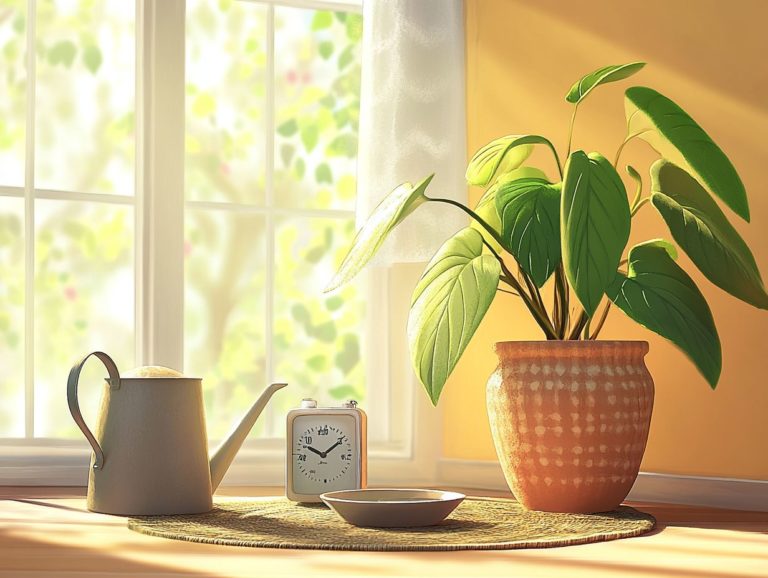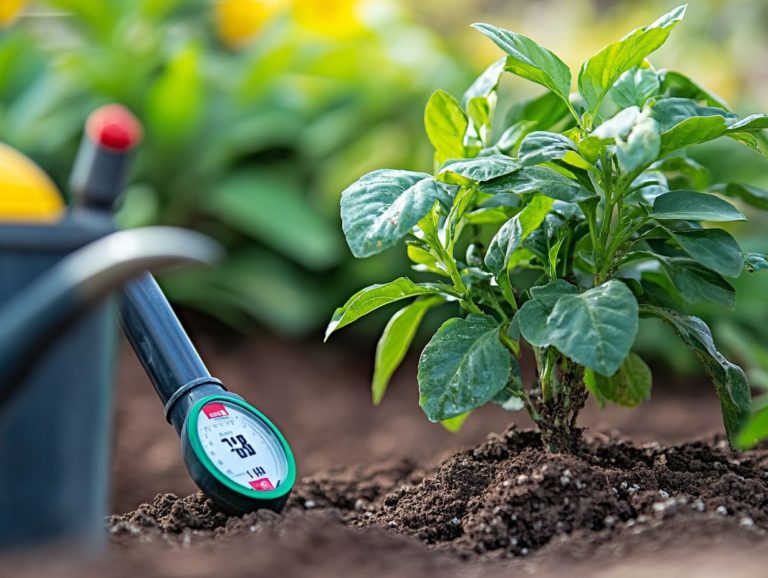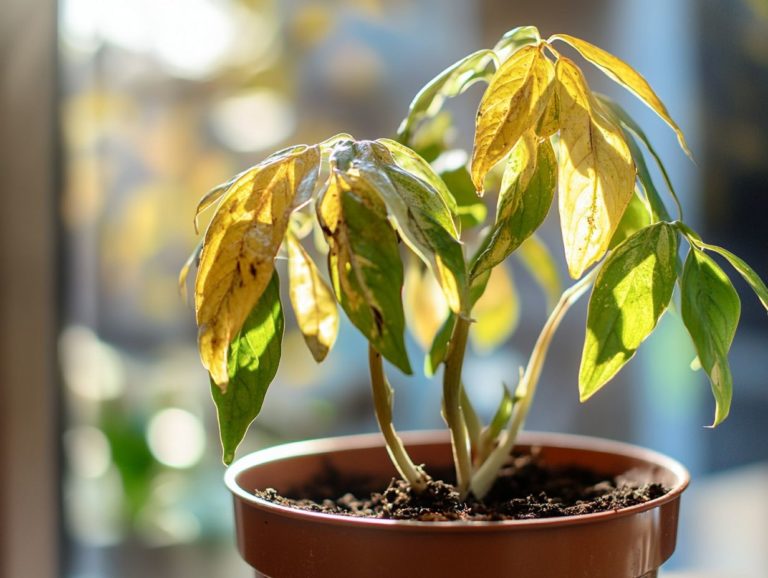How to Create a Watering Schedule for Your Plants
Want to keep your plants thriving? Establishing a watering schedule is crucial for nurturing healthy plants and maximizing the productivity of your garden, especially when considering various watering techniques.
This article delves into the benefits of maintaining a consistent watering routine. You ll be able to tailor your personalized schedule to different plant types and local climates. Discover a step-by-step guide for creating your own watering schedule, complete with tips for maintaining it and adjusting to changing conditions.
Explore alternative methods such as drip irrigation and rain barrels. These can save time and resources while keeping your garden healthy.
Start improving your plant care today!
Contents
- Key Takeaways:
- Why a Watering Schedule is Important
- Factors to Consider for Your Watering Schedule
- Creating Your Watering Schedule
- Tips for Maintaining Your Watering Schedule
- Adjusting for Changes and Avoiding Overwatering
- Alternative Watering Methods
- Drip Irrigation and Other Options
- Frequently Asked Questions
- What is a watering schedule and why is it important for plant care?
- How do I determine the best watering schedule for my plants?
- What are some signs that my plants need to be watered?
- Can I create a watering schedule for different types of plants?
- How do I stick to a watering schedule?
- What Happens If I Over or Under Water My Plants?
Key Takeaways:
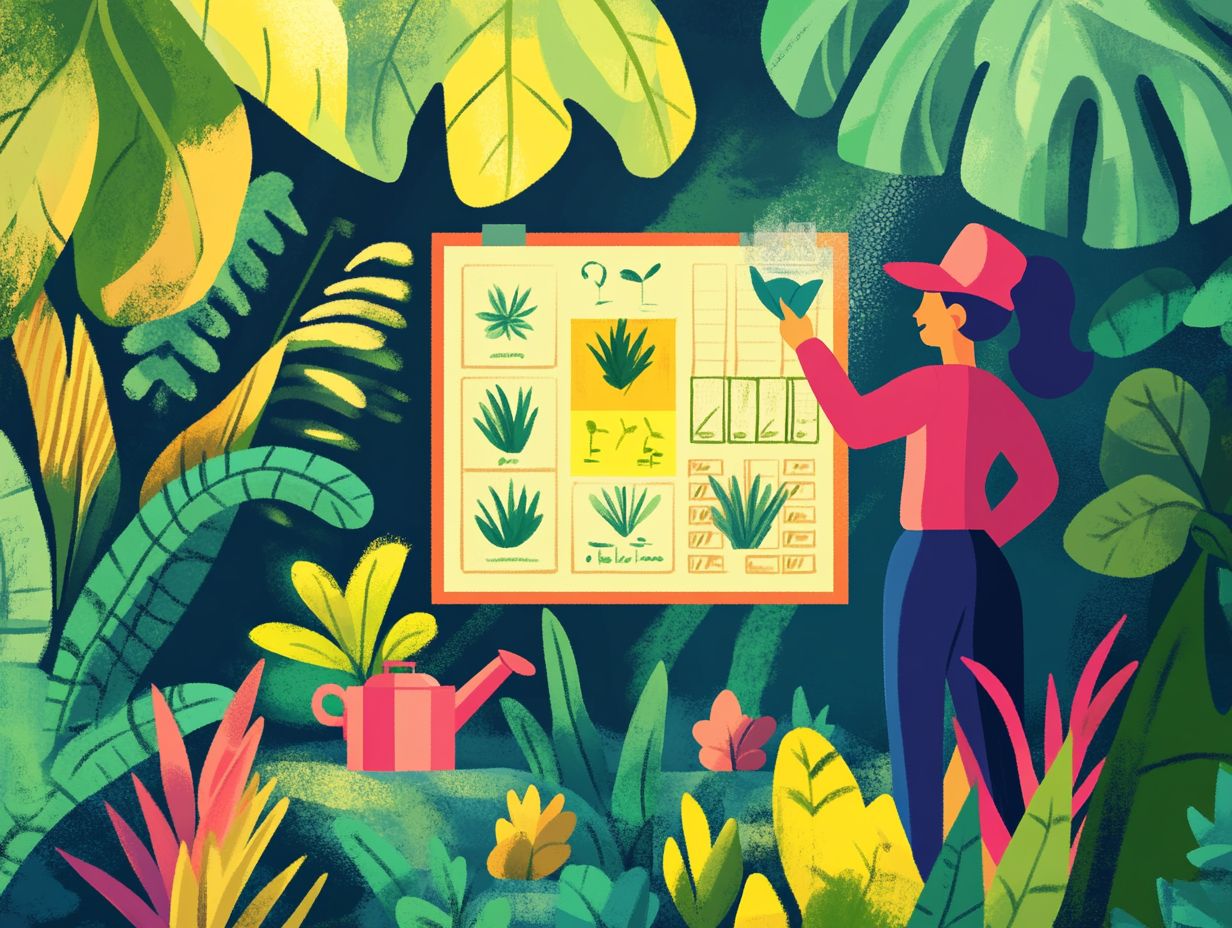
- Consistency is key when creating a watering schedule for your plants. A routine ensures they receive the right amount of water, leading to healthier and stronger growth.
- Consider the specific needs of your plants and the climate you live in. Different plant types and changing seasons will impact their water requirements.
- Maintaining your watering schedule is crucial to your plants’ health. Adjust for any changes and be mindful of overwatering. Consider alternative methods like drip irrigation to make watering more efficient.
Why a Watering Schedule is Important
Establishing a plant watering schedule is vital for maintaining the health and vitality of your plants, especially for those who aspire to integrate plant care into their busy lives.
A thoughtfully crafted watering routine guarantees optimal moisture retention while addressing specific environmental factors like humidity levels and temperature regulation. These can significantly impact various foliage plants, including Alocasia Polly and ZZ Plant.
By recognizing the importance of a customized watering schedule, you can enhance the growth, root development, and overall vitality of your indoor garden or office desk plants.
Benefits of a Consistent Watering Routine
A consistent watering routine can transform your gardening experience and lead to healthier plants. This also fosters a flourishing indoor garden with minimal stress.
By sticking to specific watering intervals, you can ensure your plants receive the perfect amount of moisture exactly when they need it. This attentive approach addresses each plant’s unique requirements, helping you avoid the pitfalls of overwatering, indicated by signs like yellowing leaves, and underwatering, which leads to wilting. For more detailed guidance, check out the best watering schedule for common plants.
Consider using a plant identifier app to elevate your routine; it offers personalized advice on the optimal watering frequency for different species. With these strategies in place, you encourage robust growth and vibrant foliage, cultivating a sense of satisfaction and mindfulness throughout your gardening journey.
Factors to Consider for Your Watering Schedule
Crafting an effective watering schedule demands careful consideration of various factors that dictate your plants’ hydration needs. This is especially true for varieties like Alocasia Polly, ZZ Plant, and Coffee Plants, which flourish under specific conditions along with Pothos and Spider Plants.
By thoughtfully assessing elements such as soil composition, environmental influences, and climate variations, you can ensure your watering regimen is perfectly tailored to each species unique requirements.
Don t forget to consider seasonal shifts that can impact humidity levels and temperature regulation. These nuances are essential for keeping your green companions thriving.
Ready to start your watering schedule? Let s get started now!
Types of Plants and Their Water Needs
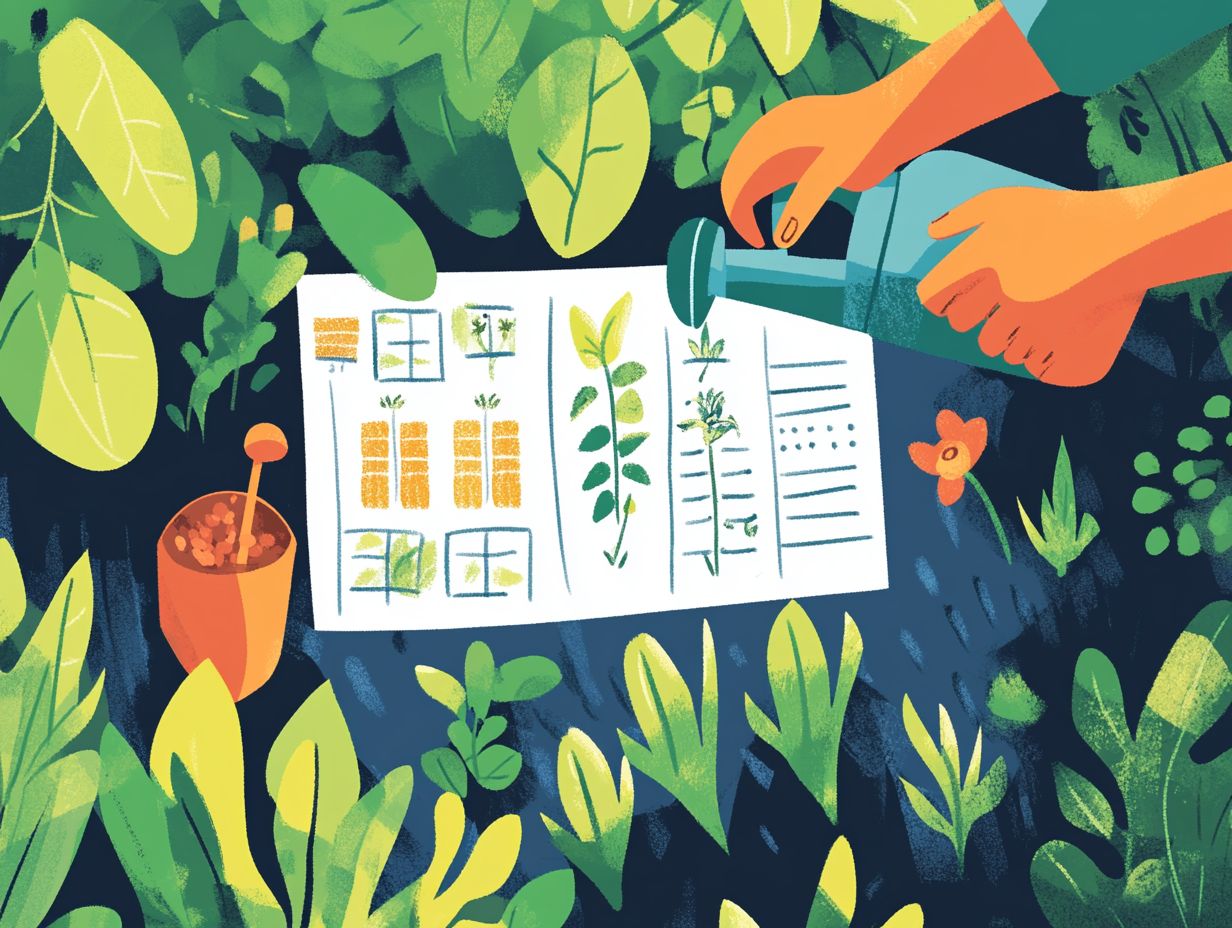
Different types of plants possess unique watering needs. For instance, while succulents like Echeveria and Haworthia thrive on minimal water due to their ability to survive with little water, Alocasia Polly prefers a more humid setting and requires a tailored watering approach.
Knowing these differences is key! Succulents are adept at storing water in their leaves, allowing them to flourish in arid conditions. They often need just an occasional drink. Conversely, moisture-loving plants like Alocasia Polly thrive when their soil remains consistently damp, requiring a regular watering schedule to support their lush foliage.
Understanding these varying needs not only aids in selecting the right plants for your environment but also enables you to build a happy plant environment that respects each species’ requirements and enhances your overall plant care.
Climate and Seasonal Changes
Understanding climate and seasonal changes is essential for fine-tuning your watering schedule. Humidity levels and rainfall patterns can greatly impact your plants’ water needs throughout the year. This may necessitate using smart controllers or timers for optimal irrigation.
For example, during the warmer months, when temperatures rise and evaporation rates climb, you may need to adjust your watering intervals to ensure your plants get the moisture they require.
As temperatures drop or during periods of heavy rainfall, adjusting how often and how much you water can help prevent issues like waterlogging and root rot.
By keenly observing local climate conditions and incorporating seasonal insights, you can develop a personalized watering plan that enhances plant health while conserving precious water resources. Don’t wait—act now to adapt to these variations and cultivate a more resilient garden! For more insights, explore the science of watering indoor plants!
Creating Your Watering Schedule
Crafting a personalized watering schedule can be a seamless endeavor, particularly if you re among the elder millennials who leverage tools like Google Sheets to meticulously track your plant care routines.
This approach not only facilitates combining diverse watering techniques like bottom watering but also allows you to employ monitoring methods, such as utilizing a moisture meter, a device that helps you check if your plant’s soil is too dry or too wet. For more guidance, check out how to water plants when you’re away to pinpoint the ideal watering times for your plants.
Step-by-Step Guide
Follow this step-by-step guide to craft a comprehensive watering schedule that caters to your plants needs while seamlessly fitting into your busy lifestyle:
- Begin by assessing factors such as the types of plants, the climate in your area, and the specific soil conditions. This tailored approach will help ensure optimal growth for your green companions.
- Next, determine how often each plant requires watering, keeping in mind that this can vary significantly between species. Consider incorporating a timer for your irrigation system or using habit trackers to automate the process, providing peace of mind on those hectic days when you might forget.
- If you choose to go the automated route, ensure you set it up according to the specific needs you identified in your assessment. Don t forget to allow for adjustments based on seasonal changes and weather fluctuations.
- Regularly evaluating your watering schedule will help you adapt to any unforeseen circumstances, ensuring your plants receive just the right amount of hydration every time.
Tips for Maintaining Your Watering Schedule
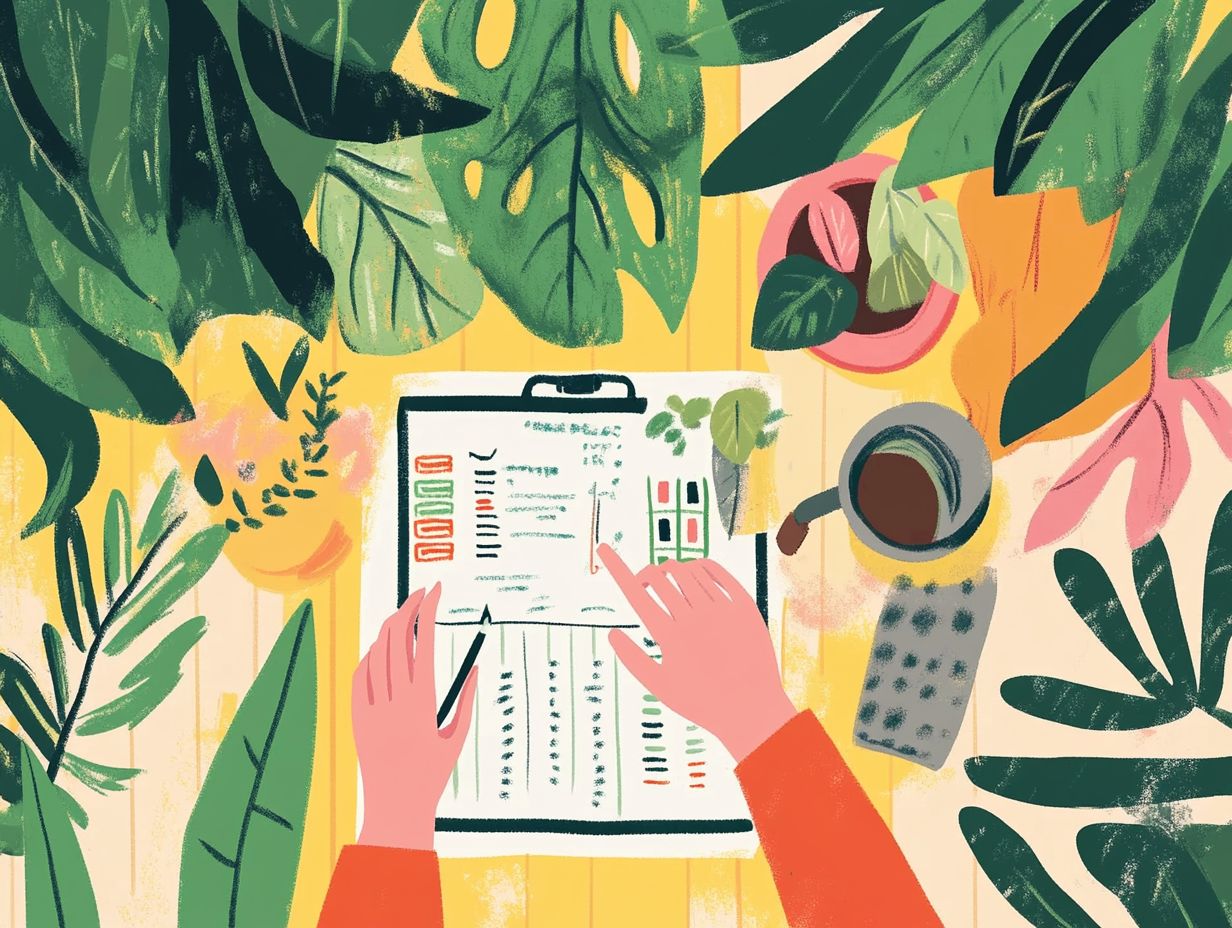
To maintain an effective watering schedule, you must engage in consistent monitoring and make necessary adjustments. This is especially true for elder millennials, who may find themselves needing to adapt their routines based on the telltale signs of overwatering or underwatering, as indicated by the health and growth of their plants.
Are your plants thriving, or do they seem thirsty? Pay attention to their moisture retention needs, especially for drought-tolerant plants. Learning how to use a watering gauge for indoor plants can help you monitor their watering needs effectively.
Adjusting for Changes and Avoiding Overwatering
Adjusting your watering schedule is essential to prevent overwatering, especially when you consider factors like soil composition and the specific watering methods best suited for each of your plants. This becomes even more crucial as environmental conditions change. For example, during the hotter months, when evaporation rates rise, your plants may need more frequent watering. Cooler weather could reduce their requirements. Understanding how well soil drains can greatly influence how often you should water.
Using methods like drip irrigation or soaker hoses can enhance water delivery efficiency, minimizing runoff and ensuring that moisture reaches the root zone effectively. This is especially important for plants like Fiddle Leaf Fig and Arrowhead Vines. Regularly checking soil moisture levels allows you to gauge when watering is truly necessary, enabling you to customize your approach and promote robust, healthy growth. Additionally, consider learning how to create an indoor plant care schedule to further optimize your plant care routine.
Alternative Watering Methods
Exploring different ways to water your plants opens up a world of innovative solutions for you as an elder millennial aiming to elevate your plant care routine. Consider options like drip irrigation and rain barrels, which not only enhance water efficiency but also adapt seamlessly to the diverse needs of your plants. Try these techniques and watch your plants thrive!
Drip Irrigation and Other Options
Drip irrigation stands out as one of the most efficient watering methods available. It conserves water while ensuring your plants enjoy the consistent moisture they crave particularly beneficial for those varieties that flourish under stable conditions. This system delivers water directly to the roots, dramatically cutting down on evaporation and runoff, which is essential for promoting robust growth. Unlike traditional methods like sprinklers, this technique offers a targeted approach that caters specifically to the unique water needs of various plant species.
Innovative solutions like soaker hoses and misting systems can elevate soil moisture levels without squandering valuable resources. By embracing these technologies, you can cultivate healthier crops while minimizing your overall water consumption truly an excellent choice for sustainable gardening and farming practices.
Frequently Asked Questions

What is a watering schedule and why is it important for plant care?
A watering schedule is a planned routine for watering your plants. It is important because it helps to ensure that your plants receive the right amount of water at the right time, promoting healthy growth and preventing over or under watering.
How do I determine the best watering schedule for my plants?
The best watering schedule depends on various factors such as the type of plant, its location, and the climate. Generally, most plants need to be watered once or twice a week. However, it is important to research and understand the specific needs of your plants for a more accurate schedule.
What are some signs that my plants need to be watered?
Some common signs that your plants need to be watered include wilting leaves, dry soil, and a lighter weight when lifted. However, these signs may also be indicators of other issues, so it is important to monitor your plants regularly and adjust your watering schedule accordingly.
Can I create a watering schedule for different types of plants?
Yes, it is recommended to have a separate watering schedule for different types of plants. Some plants may require more frequent watering, while others may need less. It is important to research and understand the specific needs of each plant to create an effective watering schedule.
How do I stick to a watering schedule?
To stick to a watering schedule, it is helpful to set reminders on your phone or calendar, use a watering can or hose with a timer, or delegate the task to someone else if you are away. Consistency is key to maintaining a healthy watering schedule for your plants.
What Happens If I Over or Under Water My Plants?
Overwatering or underwatering your plants can harm their health. If you don’t give them enough water, they may wilt or grow slowly.
On the other hand, giving them too much water can cause serious problems, like decay in their roots. It’s crucial to follow a regular watering schedule and keep an eye on your plants to give them just the right amount of water!

